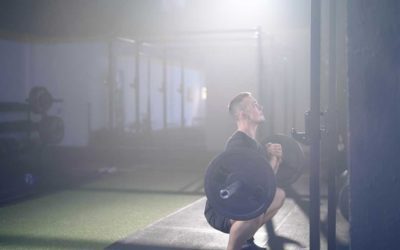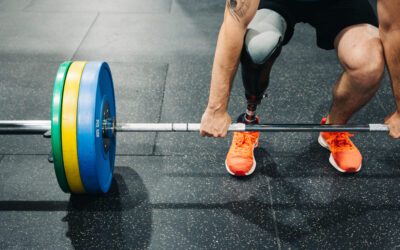A Newbie’s Guide to Progressive Overload

In the spirit of our campaign to “change the way you train,” TrainHeroic’s fitness pros wanted to give our newer athletes a primer on one of the tried-and-true methods for making gains regardless of your discipline: progressive overload.
Chances are you’ve run into the principles of progressive overload, but if you’re programming for yourself, how do you implement them in your own training? Can you tell when your coach is using progressive overload on your big lifts?
If you haven’t heard of PO, it’s the answer to your chronic habit of “just winging it” in the gym and wondering why you’re not making progress. Read up.

Change the Way You Train
What is Progressive Overload?
Progressive overload is a crucial concept for any athlete looking to improve their strength and conditioning — so, pretty much all of us. Simply put, progressive overload refers to the gradual increase of stress placed on the body during physical activity with the goal being to adapt to newer and higher planes of physical prowess.
You can track this through a lot of different metrics, like (obviously) increasing the weight you lift or the number of reps you perform for a given weight from week to week. But it also applies to skill sets and time domains like distance or duration of the workout.
By consistently challenging your body with progressively harder workouts, you can make massive strength gains over time. It pays big to know how to use progressive overload properly, since you can basically keep doing so through the life of your athletic career.
How to Program Progressive Overload
As a beginner, it can be tempting to try and progress too quickly in your training. There’s nothing quite like that honeymoon phase of newbie gains where you’re adding weight every week, setting new PRs constantly. It’s a next-level addiction for driven people.
But packing on the poundage blindly can lead to injury and burnout, which can set you back hard. Instead, it’s important to start slow and gradually increase the difficulty of your workouts over time. This allows your body to adapt to higher stress, giving your joints and tendons time to catch up.
Designing your program to take you through increasingly challenging workouts will help you work through plateaus and see continuous growth in your strength, endurance, hypertrophy, power output, or whatever your goals might be.
So, what are some ways to use progressive overload in your training?

Periodization
Periodization involves dividing the training year into distinct phases, each with its own specific goals and objectives. This might mean aiming to compete multiple times per year, or just shooting for one or two bigger goals (lose weight for the wedding, sign up for your first Crossfit Open, add 15lbs to your back squat PR).
In the early phases of a periodized program, the focus is typically on building a strong foundation. This might involve a higher volume with lighter weights with a greater emphasis on technique and form. As you work through the program, the focus will shift to more intense, specialized training, with an emphasis on increasing the weight you’re moving and the overall difficulty of the workouts.
Variation
One important aspect of progressive overload is the concept of variation. By regularly switching up your workouts and trying new exercises, you can avoid boredom and keep your body adapting to new stimuli. This can be the key to preventing plateaus.
If you’re struggling to gain size in your back, but you’re only doing the same 2-3 lifts on back day, try adding in a couple of new movements — like this one — to attack your back muscles from different angles.
It’s also a good idea to incorporate a mix of different types of training, even for sport-specialists. Your weightlifting numbers will improve if you have good cardiorespiratory endurance (lung capacity) to perform. How do you get that kind of breathing stamina? Put down the barbell and suffer through some long zone 2 cardio work. Sounds lame, but it works.
Recovery
One massive key factor to consider when implementing progressive overload is your recovery. In order for your body to adapt to the increased stress of your workouts, you NEED to give it adequate time to rest and recover. This means getting enough sleep, eating the right diet for your sport/goals, and incorporating rest days into your training schedule.
Active rest days can be incredibly useful in this case, especially if you need a little more variation in your training. Go for an easy swim on your day off to keep your tissues from getting stiff. Yoga, hiking, and playing with the kids outside are other great active recovery methods.
And don’t forget about mobility. Check out our big piece on it for inspiration —
Mobility Exercises 101: Your Complete Guide From Head to Toe
Progressive overload is a fundamental concept to understand for all athletes, but many of us don’t get the right exposure unless we’re working with a coach. If you’re self-coached, it helps to get real with your programming methods and keep your eyes on your goals.
By gradually increasing the difficulty of your workouts over time, you can net the gains you want in basically every facet of your fitness. Just remember to start slow, incorporate variation and prioritize your recovery in your training.
With consistency and hard work using progressive overload training, you can land new PRs, level up your skills, and hit the podium at your local comp.
Master yourself, impress your friends, perform your best.
Find Your Perfect Training Plan
Sometimes all you need to reach your destination on your fitness journey is an expert guide. We've got you covered. Browse from thousands of programs for any goal and every type of athlete.
Try any programming subscription free for 7 days!
Want Training Tips, Exercise Guides & Knowledge Bombs Sent to Your Inbox?
Sign up for the FitNerd newsletter from TrainHeroic
Related articles
How To Zercher Squat: One Exercise To Rule Them All
I have a secret weapon exercise that will get us really close; it has a lot of bang for its buck. It builds massive quads, big glutes, a wide back, and some awesome biceps. Exactly what every athlete needs.
What Does Paralympic Strength Training Look Like?
Paralympians undergo rigorous training when preparing for the Paralympic Games. While the Paralympics only last about two weeks, getting ready takes place all year, as these athletes are among the most dedicated in the world. Here’s how people with disabilities...
Your Guide to Passive Recovery Strategies
What is Passive Recovery? I don’t think that there exists a complete guide for athletes that tackles the underrated topic of “Recovery-Regeneration” strategies. I plan to disclose a majority of the scientific and practical information that I know of on this topic and...

Join the community
Sign up for the latest training news and updates from TrainHeroic

About TrainHeroic
Support
Made with love, sweat, protein isolate and hard work in Denver, CO
© 2022 TrainHeroic, Inc. All rights reserved.






